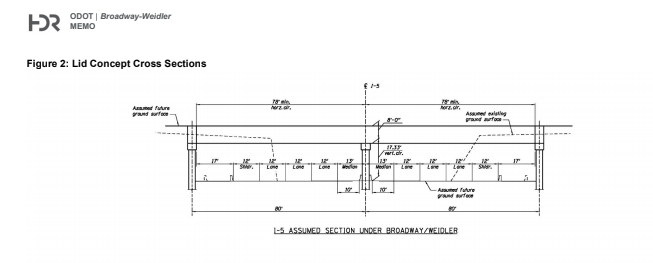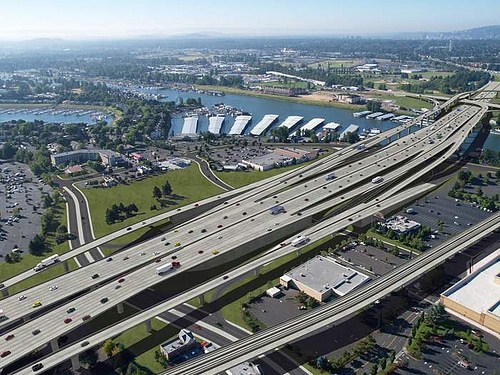What City Observatory this week
1. Revealed: Oregon Department of Transportation’s secret plans for a ten-lane I-5 freeway at the Rose Quarter. For years, ODOT has been claiming that its $800 million freeway widening project is just a minor tweak that will add two so-called “auxiliary” lanes to the I-5 freeway. City Observatory has obtained three previously undisclosed files show ODOT is planning for a 160 foot wide roadway at Broadway-Weidler, more than enough for a 10 lane freeway with full urban shoulders.
ODOT has failed to analyze the traffic, environmental and health impacts from an expansion to ten lanes; not disclosing these reasonably foreseeable impacts is a violation of the National Environmental Policy Act (NEPA).
2. The cost to Oregon of reviving the failed Columbia River Crossing project just went up by $150 million. Buried in an Oregon Department of Transportation presentation earlier this month is an acknowledgement that the I-5 bridge replacement “contribution” from Oregon will be as much as $1 billion—up from a maximum of $850 million just two months earlier.
Must read
1. xx
2. Cities, Covid and the Fog of War. City Observatory friend David Gisburg and his colleague Dave Smith, both Cincinnati-based executive recruiters have been interviewing city leaders around the country on the lessons to be learned from the Covid-19 pandemic. They’ve summarized the results of more than 100 interviews in an essay entitled “Fog of War.” It’s an apt metaphor: In the midst of the pandemic, we’ve all had to deal with dire and largely unanticipated problems, often with incomplete misleading or misinterpreted information. In the face of this danger and uncertainty, how should urban leader’s respond? Their summary, Downtown Leaders – 2020 Lessons Learned: The Pandemic, Civil Unrest and Future Impact, addresses several critical urban topics including: How downtown and center-city leaders responded to the exceptional challenges presented during the year of COVID. Identifies the unique value downtown organizations provided to meet critical needs during a pandemic while driving future visioning. Provides and overview of downtown challenges and opportunities for 2021 and beyond. Characterizes leadership lessons learned and “talent” required to meet future challenges. The report draws on more than 100 Zoom conversations with downtown CEO’s, industry consultants, philanthropists, and market influencers between August, 2020 and January, 2021. The Fog of War explores 9 key issues and addresses “headwinds” and “tailwinds” faced by downtown leaders as they navigated the swirling urban landscape created by COVID-19.
3. Bellevue thinks another freeway interchange will solve its traffic problems. Portland isn’t the only city that thinks that congestion can be solved by throwing more money at antiquated freeway solutions. The fast growing suburb east of Seattle hopes that by adding more interchanges to I-405 near the cities downtown it can lessen congestion. But, as The Urbanist points out, this kind of solution invariably makes the problem worse.

Bellevue needs another freeway interchange
New Knowledge
In the News
Willamette Week quoted City Observatory’s Joe Cortright in its story revealing the previously undisclosed plans by the Oregon Department of Transportation to widen I-5 to ten lanes at the Rose Quarter in Portland.
Streetsblog California pointed its readers to our customized Portland version of the Induced Demand calculator.
The Niskanen Center’s newsletter, This Week in Land Use Regulation highlighted our commentary on the connection between segregation and racial housing value disparities.


